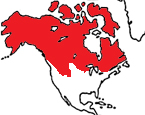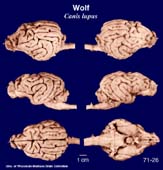|
Wolf
Canis lupus
There are seven other species in the
genus Canis, and C. lupus,
or the Wolf includes the largest individuals
within the family Canidae. Head and
body length of C. lupus is 1,000-1,600
mm and tail length is 350-560 mm.
There are subspecies of C. lupus,
for example C. lupus arabs
found on the Arabian Peninsula, who
are much smaller in size. Overall,
males are larger than females. Weights
are 20-80 kg for males and 18-55kg
for females. The coloration ranges
from light brown to gray tipped with
black and the legs are yellowish white.
All white, but not albino, individuals
occur with some frequency on tundra
regions and well as elsewhere. All
black individuals are also common
in some populations.
C. lupus has the largest natural
range of any terrestrial mammal other
than Homo sapiens. It is found in
all habitats of its North American
range with the exception of tropical
forests and arid deserts. C. lupus
uses dens to rear its young, and these
may be located in the crevices of
rocks, a hollow log or uprooted stump,
or, most commonly, a burrow which
the Wolves either dig themselves or
adapt from a previous inhabitant.
Optimum sites for these dens are elevated
and have water nearby. Several dens
may be constructed in one area and
each burrow can have several entrances
with 2-4 meter long tunnels leading
to the main chamber. The pups are
born and cared for here and when they
are about 8 weeks old, are moved to
a rendezvous site. Here, the pups
are introduced to the rest of the
pack and may romp and play in this
location for 1-2 months. Movement
occurs mainly at night, but they becomes
more active during daylight when the
weather turns colder. The pack is
also more transient during the colder
months, traveling in single file along
streams, pathways, and ice-covered
lakes, and do not necessarily return
to a specific location. Hunting seems
to have a significant impact on how
far the animals travel at any given
time. C. lupus generally hunts
prey larger than itself, though large,
healthy animals who stand their ground
are usually left alone. Prey animals
include wapiti, moose, caribou, deer,
bison, musk ox, mountain sheep, and
beaver.
The Wolf is among the most social
of all mammals, living in packs which
are usually family groups averaging
5-8 animals, but may contain as many
as 36 individuals. Relationships between
packs, however, are hostile, and may
result in fierce fighting and even
death. Ranges are the size of defended
territory and buffer zones in which
no Wolves live, tend to result between
the territories of neighboring packs.
C. lupus communicates with
a variety of olfactory, visual and
auditory means. Scent marking, urination
scratching, defecation, and howling,
are all used to keep the pack together
and warn intruders.
Within a pack, reproduction is limited
to the dominant or Alpha female. Estrus
lasts 5-15 days, gestation is 62-63
days. Mean litter size is 6 pups but
may range from 1-11 offspring. At
birth the pups weigh about 450 grams
and are deaf and blind. They develop
quickly, emerging from the den at
3 weeks of age and are weaned at about
5 weeks. The female stays with her
pups while the male goes out to hunt,
brining back food for the female and
the pups. Initially, the pups are
fed by regurgitation. At 8-10 weeks
the family begins moving from one
rendezvous site to another. C.
lupus reaches sexual maturity
at about 22 months of age, but the
social hierarchy of the pack prevents
the youngest animals from mating.
Life expectancy can be from 14-16
years.
C. lupus is found through the
N Hemisphere: North America south
to 20ºN in Oaxaca (Mexico); Europe,
Asia, including the Arabian
Peninsula and Japan, excluding Indochina
and S India. Extirpated from most
of the continental USA, Europe, and
SE China and Indochina. Afghanistan,
Albania, Armenia, Azerbaijan, Belarus,
Bhutan, Bulgaria, Canada, China, Egypt
(?), Estonia, Finland, France, Georgia,
Greece, Greenland, Hungary, India,
Iran, Iraq, Israel, Jordan, Krygyzstan,
Latvia, Lebanon (?). Lithuania, Macedonia,
Mexico, Mongolia, Nepal, Norway, Pakistan,
Poland, Portugal, Romania, Russia,
Saudia Arabia, Serbia and Montenegro,
Slovakia, Spain, Sweden, Syrai, Tajikistan,
Turkey, Turkmenistan, Ukraine, USA,
Ubzbekistan.
|



